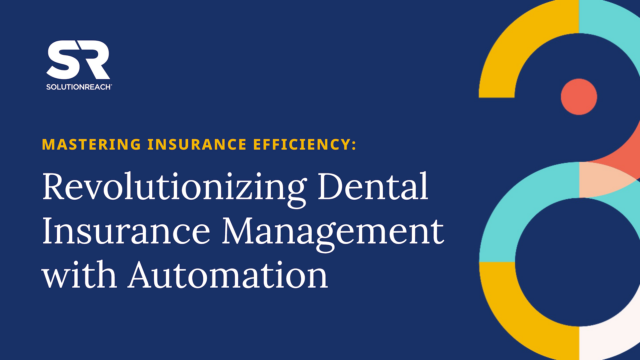The truth of the matter is it’s become increasingly challenging to run a profitable dental, vision, or medical care practice in 2023. With soaring costs, staffing challenges, a more frenzied office environment, patient satisfaction/retention concerns, and growing marketplace competition, you’ve got to innovate and adapt just to survive. That means looking for ways to step up productivity, cut costs, and adopt efficiencies that allow your staff members to assist more patients in less time.
Some of the keys to successfully managing your healthcare office include proactively taking these steps to avoid inefficiencies:
- Updating and fine-tuning appointment processes and workflows
- Adopting front desk/office operational best practices
- Consolidate and upgrade to new technology
But once you’ve made these refinements, how do you track actual progress? How do you know their true impact? Quite simply, you’ve got to measure specific aspects of your business performance, or key performance indicators (KPIs). Only by comparing variables like your current no-show rate, phone hours reduced, and revenue increases against past performance can you get a clearer picture of your return on investment.
In this article, we’ll look at what some of those KPIs should be, what new benchmarks might look like, and some examples of how a modern patient communications platform can deliver the results you’re looking for.
What kinds of healthcare practice KPIs do I need to measure and track?
The first area to target is metrics related to your individual patient communications and outreach. Are you reaching more patients more efficiently and effectively? Have automated patient care communication tools helped you book more appointments, shrink no-shows and late cancellations, and expand your reach to patients? These data points include examples such as:
- No-show rate
- Confirmation rate
- Appointment reminders sent
- Two-way text messages or batch messages sent
- Post-appointment patient surveys sent
- Online reviews and 5-star ratings collected
The other category of KPIs you want to chart is your front office operations. These numbers give you a better idea of to what degree your office systems and workflows have saved your admin team time, minimized repetitive manual tasks, increased your accounts receivable (A/R), and reduced your costs. Examples of these indicators include:
- Phone hours saved
- Cost reductions
- Staff time saved by minimizing manual tasks
- Collections gains
- Revenue increases
By regularly tracking and analyzing these statistics, you’ll be able to make tweaks and adjustments to improve performance and get a better grasp of your software’s impact. You’ll also be better positioned to bring about continued growth in your office’s streamlined productivity, financial and operational savings, frontline staff efficiency, and profitability margin.
What type of results should I expect from investing in patient communications and office operations solutions?
While every healthcare practice has its own unique circumstances and results will vary, you should expect your technology upgrades to have a sustained and pronounced impact. Some KPIs may show immediate improvement, while others may steadily develop over time. Below are examples of what actual healthcare practices experienced when adopting leading patient communications tools:
No-Show Rate
A New York area optometrist leveraged automated texts and emails sent from an appointment reminder solution to produce a no-show rate of less than 5%.
Recall Appointment Scheduling
A California vision practice utilized an automated recall notification tool to book 90% more recall visits. Applying the same recall solution, a Texas-based dental service organization’s (DSO) offices took in an extra $3 million a year in recall revenue.
Confirmation Rate
A dental practice in California doubled its confirmation rate by employing an appointment reminder tool that enabled it to send patients multiple text, email, or voice reminders at key intervals.
Phone Hours Reduced
An ophthalmology office in Utah saved their admin team 10 hours per week of reminder calls by implementing appointment reminder software. At the same time, a dental practice in Michigan sent out 150,000 appointment reminders over a 10-year period, saving its front office staff a nearly equal amount of phone calls.
Reduced Manual Task Hours
A pediatric medical practice in Stockton, Calif., used its recall notification software to save its front office staff 200 hours per month in manual recall efforts.
Online Reviews & New Patient Acquisition
After introducing a reputation management tool, a pain management practice increased its 5-star online review by over 200%. The solution also helped them to see a 328% increase in patient review responses. Meanwhile, a pediatric dentistry office gained 50% of their new patients from online reviews posted by returning patients with a review invitation solution.
Collections Gains
An ophthalmology practice in Salt Lake City boosted its revenue with a 15% increase in payments from outstanding accounts with reminders sent from a patient texting tool.
Key Takeaways
Ensure new processes and patient communications tools drive the results you seek by identifying and measuring KPIs to improve your practice’s productivity and overall production. These upgrades will allow you to make sustained and considerable improvements and better enable you to set goals and new benchmarks in minimizing missed appointments, boosting your appointment volume, and increasing your return on investment.

To learn more about how to determine which practice KPIs can help you better manage and expand your business, download the guide “10 Must-Have Metrics to Grow Your Practice.”
Read the Guide


